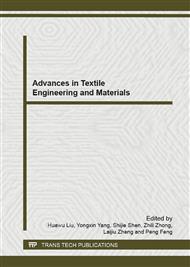p.844
p.849
p.855
p.859
p.864
p.869
p.873
p.878
p.885
Anti-Reflective Structure of PMMA/Glass Fiber Membrane Produce by Argon Plasma Etching and Variation of Transmitted Intensity
Abstract:
The aim of this research is to increase the membrane’s transmitted intensities; it used Argon plasma etching to process the anti-reflective structure on PMMA/glass fiber membrane surface. The anti-reflective structure could increase the light transmission at the identical specification of membrane’s basic cloth. Membrane’s transmitted intensities can directly affect it products competitiveness. The parameter of experimentation set with distance between sample and RF plate are 19 or 5.5 centimeters, plasma output power is 270, 240, 210 Watt respectively, each process time is 6, 12, 18, 24, 30 seconds. In this stage, the best transmitted intensity of parameter is 19cm, 210W, 30sec; it increased 2.4 % than non-treatment sample. The summary of this study, decreased plasma output power would reduce the impact extent of plasma gas but uniformity of structure should increase. Decreased the distance between sample and RF plate can avoided the degeneration of energy, reinforced the problem of insufficient etching and reduced the turbulence.
Info:
Periodical:
Pages:
864-868
Citation:
Online since:
December 2012
Authors:
Keywords:
Price:
Сopyright:
© 2013 Trans Tech Publications Ltd. All Rights Reserved
Share:
Citation:


